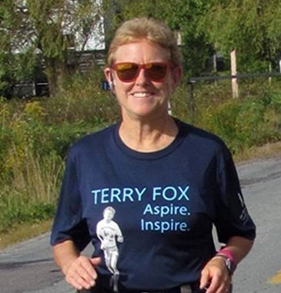Finding hope and help where it seems there is none: Living with Fibromyalgia

Trudy, IMHA Patient Ambassador
After many visits to address persistent neck and hip pain following a motor vehicle accident, Trudy’s general practitioner was finally able to make a diagnosis: she had fibromyalgia.
This was 22 years ago.
In hindsight, Trudy remembers living with shoulder and leg pain, exhaustion, and sustained periods of brain fog for many years. She now attributes these symptoms to an earlier exposure to mould, 5 years prior to her diagnosis. With the exposure to mould, Trudy and her daughter (who was also diagnosed with fibromyalgia) developed asthma and multiple chemical sensitivities as well.
Their lives were greatly impacted by the severity of their symptoms.
But it took the accident for Trudy to get the diagnosis that explained it all.
Out of the darkness into the light
In 2009, Trudy saw an invitation in the newspaper for volunteers with fibromyalgia to take part in a clinical trial that the Nova Scotia Pain Clinic was undertaking to investigate the effects of Qi Gong on fibromyalgia.
Deeply rooted in Chinese medicine, this approach aims to restore balance in one’s Qi, which means “life energy” through “gong”, which loosely translates into “cultivate” through a special blend of meditation, and movements.
This dynamic mother-daughter duo practiced these gentle movements and meditation every day and attended weekly group sessions together. Within a year, they were both feeling better, and felt well enough to stop taking their fibromyalgia medications.
Unfortunately, while this complementary form of alternative medicine helped, the positive effects were not permanent, and likely would not work for everyone.
More recently, Trudy and her daughter have experienced many flare-ups, some worse than others. However, they remain positive and maintain an active lifestyle – a key ingredient in their self-care management strategies. Both are quick to acknowledge what works for them may not for someone else.
Misconceptions abound
Fibromyalgia is a complex disease that is difficult to describe, and hence, difficult to diagnose.
Trudy reminds us that everyone with fibromyalgia has a different life story and a different set of symptoms. This difference often makes it difficult for patients to describe their symptoms and even more challenging to get a diagnosis.
“Fibromyalgia (FM) is characterized by chronic widespread pain, unrefreshing sleep, physical exhaustion, and cognitive difficulties. It occurs in all populations throughout the world, with prevalence between 2% and 4% in general populations.”
Patients will tell you it is difficult to describe how they feel to others. Trudy explains that when you say you have exhaustion, many well-intentioned listeners assume that you are just tired. However well meaning, fibromyalgia patients will tell you that others often don’t understand the extent of their exhaustion. You can sleep for hours and still wake up feeling like you don’t have the energy to get out of bed.
“This is not exhaustion that sleep can cure; this is exhaustion where it takes an effort to move. Brain fog is the same way, when you say you have brain fog people will often say oh that is just age, or I have that as well. But fibromyalgia brain fog, for me, is like there is heavy cotton balls filling my head.
Your head is so heavy and you sometimes can’t even remember your own phone number. You learn to write everything down because even if you think your mind is clear and you will remember what you have been told or read, often, a half an hour later, you can’t. I used to be so good with numbers. If someone told me their phone number I didn’t need to even write it down, I would just remember it. Now some days I can’t even remember my own phone number.”
In Trudy’s case, the pain alternates between deep-bone pain and muscle pain. Some days, she finds it is difficult to determine which is worse.
Many people also don’t understand that fibromyalgia has other symptoms, including blurred vision, numbness in different parts of your body, and an increased sensitivity to light, touch, and noise.
In 2014, the CIHR-James Lind Alliance Adult Fibromyalgia Priority Setting Partnership Steering Committee was looking for a patient advocate with fibromyalgia to represent Nova Scotia. Trudy’s name was put forward by the Nova Scotia Pain Clinic because of her multifaceted lived experience as a caregiver, patient, and nurse (off work on disability).
After completion of this project, Trudy was invited to attend the Canadian Pain Research Conference as a patient advocate. Shortly afterwards, the Canadian Institutes of Health Research (CIHR)’s Institute of Musculoskeletal Health and Arthritis (IMHA) asked her to become one of their Research Ambassadors.
Trudy is making a valuable contribution representing the interests of fibromyalgia patients, a testament to the value that her vast lived experience brings to the conversation.
As a patient advocate, she views her role as promoting an increased awareness of fibromyalgia and ALL of its symptoms. She advocates for more CIHR funding to find the cause of fibromyalgia and answers to the myriad of questions surrounding this disease. For example, is fibromyalgia an immunological problem, or is it a neurological condition, or both? It will be through finding answers to these questions that we can truly find solutions for future generations.
Hope springs eternal
Unless we can find out what causes fibromyalgia, we can never hope to find treatments and eventually a cure. Trudy wants to push for more patient representation in all research, but particularly fibromyalgia research. This is a disease where patient input is so valuable because there can be so many different symptoms.
According to Trudy, “We are the “lived expertise” (meaning that we have experienced/continue to experience fibromyalgia) and we can provide researchers with knowledge to aid in their/our research.”
Success for Trudy would be to:
- Have patients compensated fairly, in recognition of their roles as full-partners in research
- Find the cause of fibromyalgia and all its symptoms
- Develop testing so that people are diagnosed and symptoms managed early
- Uncover effective treatments and continue to work towards a cure

Trudy proudly wearing a t-shirt featuring her idol, the late Terry Fox.
The Last Word
“Without CIHR funding, people will continue to suffer with a disease that totally changes and debilitates their lives and a disease that no one understands. We need to find the cause. We need to develop testing and treatment options and better educate our doctors. I don’t think this disease is taken seriously enough considering the impact it has on so many Canadians. We need to validate the reality of patients living with fibromyalgia. Right now, we are all just trying to find our own way through the pain and myriad of symptoms, because doctors don’t have any answers. ”
- Date modified: